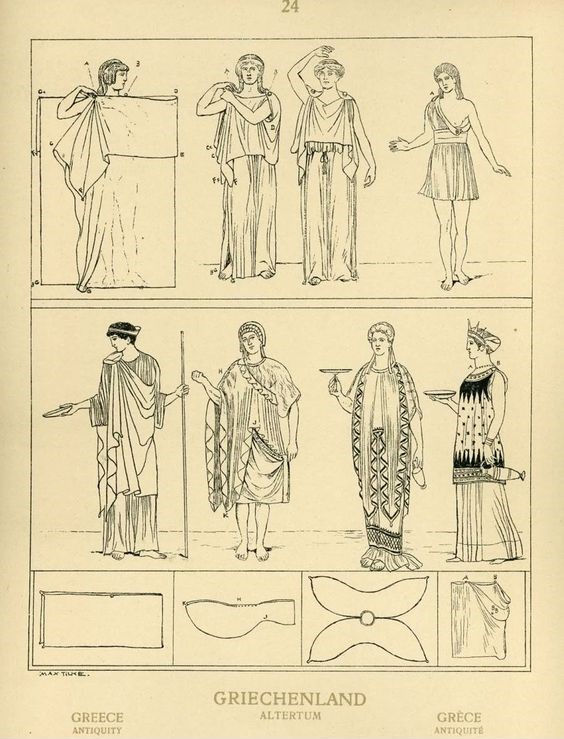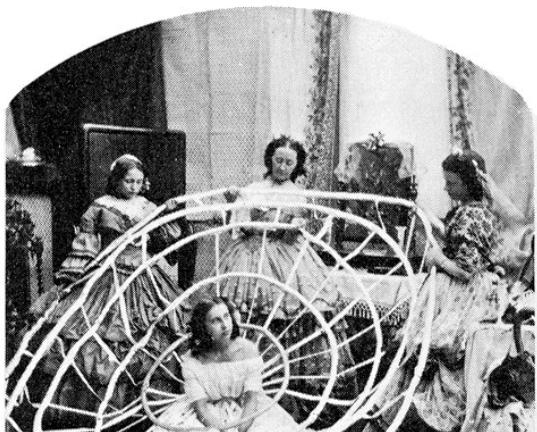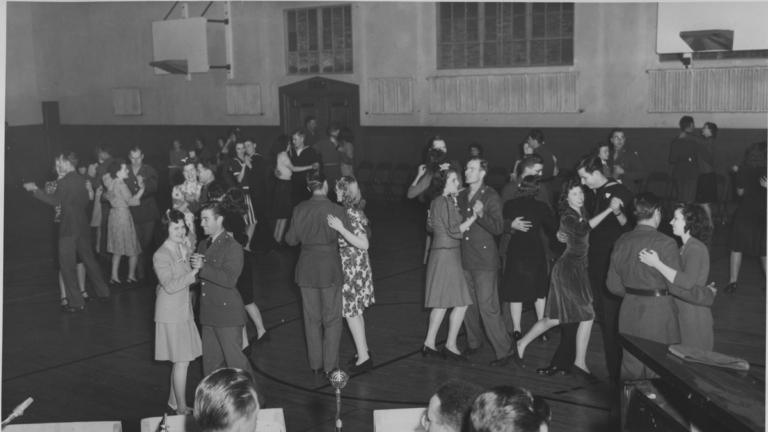How I made my Goddess Hera Costume

By Sabrina L. Nelson
GBACG Member
Research
I’m from the “historically approximate” school of costume design. This means that while I will do a lot of research to make something look as period as possible, I don’t follow all the rules because I want to add more personal touches, and I love shine and glitz. So I Googled “Greek robe” and discovered that the typical Greek robe was a chiton. The historical chiton was simply a wrap of fabric attached at the shoulders and then tied around the waist with a rope. You can see in the top row of this illustration that there might also be an “overhang” so that an extra drape of fabric extended from the shoulders and over the torso.
You also see an extra drape of fabric that covers one shoulder and drapes across the body, in the second row of the first picture and in the second picture. This is called a himation. The himation was a square of cloth, sometimes trimmed. It could be draped around the body in a number of ways, such as a shawl, or to provide modesty.

Source: Pinterest

Source: Pinterest
I chose the Goddess Hera for my costume because she’s very powerful and plays tricks on those that wrong her. According to ThoughtCo.com:
Hera (Juno) is the queen of the gods. She is usually plotting either to favor the Greeks over the Trojans, as in Homer’s ‘Iliad,’ or against one of the females who has caught the roving eye of her philandering husband, Zeus. At other times, Hera is shown plotting mischief against Heracles.
Hera’s favored animals are the cow and the peacock. I planned the gown for the PEERS Pre-Raphaelite Ball—the Pre-Raphaelites painted Greek Gods. I didn’t want to lug either animal around with me because I’d be dancing, so I decided to incorporate peacock colors into the costume, and use peacock feathers in the crown and staff. I suppose my leather sandals would represent the cow. Apologies in advance to vegetarians.

Source: iStock Photo
Construction
Teal blue poly satin for the chiton – about 5 yards
Sea green poly chiffon for the himation – about 2 yards
Jewelry pieces – 4
Gold rope – 1.5 yards
Greek key trim – 2 rolls, 10’/roll
Sea green and teal permanent markers
Chiton
I measured my height from shoulder to ankle. If I wanted the extra drape, I would have also measured the length from my shoulder to my waist. With arms outstretched, I measured the distance from my left elbow to my right elbow, across my chest. The left/right elbow measurement was the width of my piece of fabric. If I wanted the extra drape over the torso, I would have added the measurement from shoulder to waist to my calculation. I omitted this step because I thought too much fabric would look bulky on me.
I cut two pieces of fabric using the above measurements, plus an inch for hem, all around. For me, the measurement across was about 4′, and lengthwise, 4.5′. Since I’d picked a very shiny satin that frayed a lot, I decided to hem each square all around. I then sewed the two fabric squares together on the long sides, keeping the top and bottom open. If I had used the extra drape, I would have made a fold at the top, so that the extra fabric would drape over the torso. I had some jewelry bits in my stash and used them to cover the four places I fastened the top of the gown: shoulders and neckline. I “painted” the clear gems in the jewelry pieces with the markers to match the gown. I added Greek key trim to the hem of the chiton and hand-colored it to match the fabric. I used a gold cord to tie the chiton around my waist.
Himation
I cut a 5-foot square of the chiffon, and then applied trim to both sides of the fabric, to seal edges and so the trim could be seen from either side. I didn’t care for the white background, so I hand-colored the trim with sea green permanent marker. The himation was folded on the diagonal, draped across my right shoulder, and then tied at the waist on the left side. Since this fabric is so slippery, I used safety pins to ensure that the himation stayed in place.
Crown
Gold wire ribbon, 2” x 8” long
Gold leaf jewelry bits
Peacock feathers
Tiny safety pins
About 8” elastic cord, ⅛” wide
To make a crown that approximated Hera’s, I took a piece of wired ribbon and pinched the ends, tacking together. To get the rounded shape of the crown, I made pleats, tacking them on one side of the ribbon. I tacked feathers across the ribbon. I finished with the gold jewelry bits on top of the feathers. The crown stays in place with the safety pins and elastic. The elastic slides under my hair.
Hera’s Staff
¾” PVC pipe, about 4′-5′ long
Gold ribbon 1 ¼” wide (about 10′)
Green ribbon 1 ¼” wide (about 4′)
Hotmelt glue
Peacock feathers
I wrapped the gold ribbon around the pipe, hotmelt gluing it at both ends. I then glued on stems of the feathers around the pipe. I covered the feather base with green ribbon, tied in a bow.
Jewelry and Hair
I wore earrings made of turquoise stones arranged in a teardrop shape. I could have also added a large gaudy necklace but decided to keep it simple. I could have pulled back my hair in a loose bun, or followed a more historic style, but I love showing off my curls, so I kept it down.
Repurposing
I was in a pinch and needed a costume in three days for the Obtainium Cup Rally last year. My friend Sonya Jew suggested I do a mermaid, since the theme of the rally was “Under the Sea,” and I remembered my Hera costume! I made a new staff, covered with seashells. I made another ribbon crown, encrusted with seashells, and I also repurposed a gold 1920s-style headdress with shells. I added a few Steampunk elements because Obtainium Cup, and voila, Lady Poseidon.
Lady Poseidon’s Staff
¾” PVC pipe, about 4′-5′ long
Gold ribbon 1 ½” wide (about 10′)
Hot melt glue
Clothes hanger
Craft foam (tubes)
Craft foam (flat)
Gold acrylic craft paint
Seashells
Package ribbon
The build for the Poseidon staff is similar to Hera’s in terms of wrapping it with ribbon. The difference is that I added a bent clothes hanger covered with craft foam, to create the fork. To do this, I drilled a hole in the PVC pipe about 8 inches from the top and threaded the clothes hanger wire through. After bending to the right shape, I covered the tines of the fork with craft foam tubing. I wrapped it all with ribbon and hot melt glued the ends to keep the ribbon in place. I finally made little craft foam points by cutting three circles about 1.5” in diameter, and then cutting out a corner of the circle. I twisted the circle into a cone, glued, and then painted with acrylic paint. For the finishing touch, I glued on seashells and a package ribbon streamer.
Lady Poseidon’s belt is a metal belt I bought from a vendor at the 2018 Costume Academy.

Copyright 2019, Sabrina L. Nelson

Copyright 2019, Sabina L. Nelson

Copyright 2019, Sabrina L. Nelson

Copyright 2019, Sabrina L Nelson

Copyright 2019, Sabrina L. Nelson
Variations
For something more historically accurate, consider using white linen. Linen was hard for the ancients to dye, so white is just fine. You could also use wool, which actually does keep you cool, even in the summer. When choosing colors, think of your character’s status and station. An upper-class person would be more likely to wear jewelry, and linen, for example, and a lower-class person might have a simple robe of thin wool, in a rust color, with frayed edges on the cloth. Also think about how much sewing you want to do, because you could make something beautiful with no sewing at all!
More information on historically correct color and fabric:
http://www.ancientworldalive.com/single-post/2017/06/08/The-Colors-of-the-Ancient-Greeks-and-Romans
https://www.encyclopedia.com/humanities/culture-magazines/textiles-greek-and-roman-world
What Ancient Romans Wore
https://www.historyonthenet.com/the-romans-clothing
What Ancient Greeks Wore
http://www.historyofclothing.com/clothing-history/ancient-greek-clothing/
Sara Harvey’s Ancient Greek Costume Primer on Patreon
https://www.patreon.com/posts/ancient-greek-2-15362375
Ancient Greek Hairstyles — the lady’s styles are very similar to Regency styles with a strip of cloth loosely tied around the hair.
https://salontreuvis.com/history-of-hairstyling-ancient-greece/
http://etc.ancient.eu/interviews/ancient-hairstyles-of-the-grecoroman-world
Ancient Greek Underwear — For the Dedicated Historically Accurate Folks
https://www.bustle.com/articles/92316-5-ancient-underwear-looks-that-are-equal-parts-fascinating-and-bizarre


Liz
I purchased a gold and shell headdress identical to yours in northern Virginia